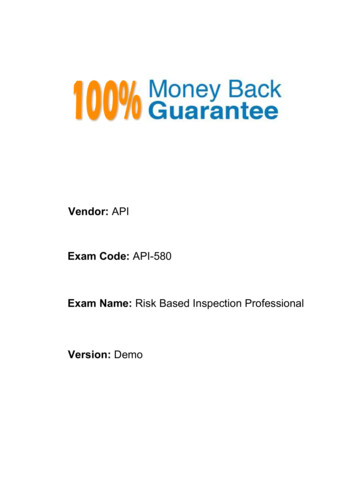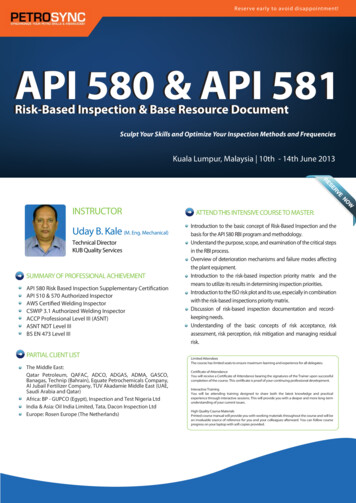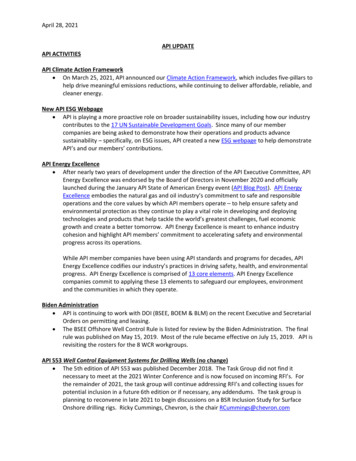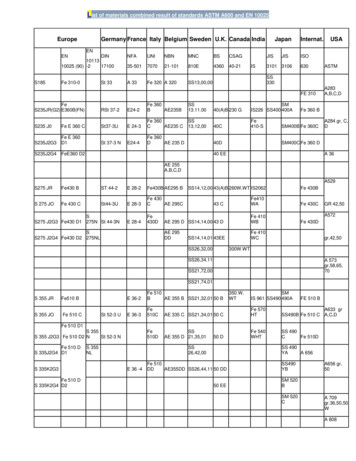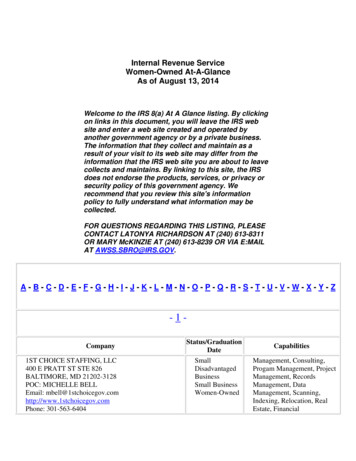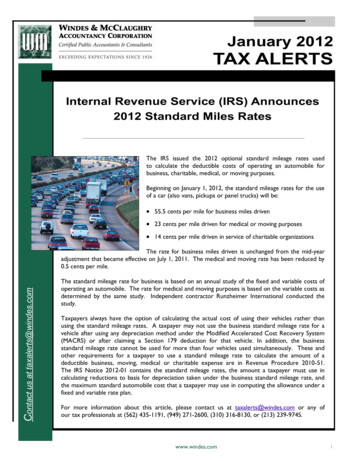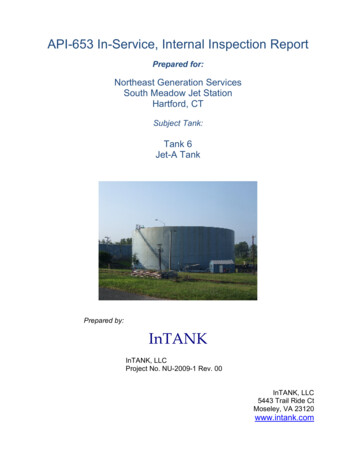
Transcription
API-653 In-Service, Internal Inspection ReportPrepared for:Northeast Generation ServicesSouth Meadow Jet StationHartford, CTSubject Tank:Tank 6Jet-A TankPrepared by:InTANKInTANK, LLCProject No. NU-2009-1 Rev. 00InTANK, LLC5443 Trail Ride CtMoseley, VA 23120www.intank.com
InTANK, LLCNortheast Generation ServicesTank 6API-653 In-Service, Internal Inspection ReportAPI-653 In-Service, Internal InspectionReportNortheast Generation ServicesSouth Meadow Jet StationTank 6Inspection Date:August 10 – 21, 2009It is recommended that this document,containing valuable historical information,be retained for the lifetime of the tank.Michael O’ConnellAPI-653 Certified Inspector, Certificate # 24021InTANKProprietary InformationAugust 2009
InTANK, LLCNortheast Generation ServicesTank 6API-653 In-Service, Internal Inspection ReportExecutive SummaryDuring the week of August 17, 2009, InTANK, LLC completed an inspection on Tank 6, the mainJet Fuel storage tank located at the Connecticut Resources Recovery Authority’s (CRRA),South Meadow facility in Hartford, CT, operated by Northeast Generation Services Company(NGS). The purpose of the inspection was to assist in the evaluation of external, chime1 /bottom plate corrosion that was identified during a recent external inspection. The most severecorrosion was found on the chime along a 7-foot section on the west side of the tank.An external, under tank inspection was completed by hand-excavating the tank foundation in thearea of the worst chime corrosion. The foundation was removed to a distance of approximately6” under the tank shell. The external surface of the tank bottom was then cleaned by handusing scrapers, files and wire brushes.The underside of the tank bottom was too rough to perform a complete UT scan, but thicknessreadings in discrete locations were obtained using manual ultrasonics. The thickness readingsranged from 0.136” to 0.210” indicating significant corrosion in this area of the tank bottom.The most severe metal loss was found closest to the tank perimeter.The main focus of the inspection was an internal, robotic inspection of the tank bottom. Specialattention was made to the tank perimeter in the area of the external chime corrosion on the westside of the tank.As with the external inspection, the robotic inspection also found significant external (underside)corrosion on the west perimeter of the tank. The minimum thickness found by the roboticsystem was 0.159”.Based on the available data and using both long-term and short term corrosion rates, it is ouropinion that the remaining service life of Tank 6 is less than three-years.Given the difficulty in predicting exact corrosion rates and given the age of Tank 6, it is ourrecommendation that the tank be removed from service within 2 years from this date (removedfrom service no later than August 2011). The tank could be inspected and repaired at that timeif desired.The tank should also be monitored on a frequent basis for signs of leaking or other distress. Itis also recommended that the amount of oil stored in the tank be kept to the minimum neededfor normal plant operation until the tank can be removed from service.1The “chime” is the portion of the tank bottom that extends outward from under the tank shell. This is also knownas the “sketch plate extension”.InTANKProprietary InformationAugust 2009
InTANK, LLCNortheast Generation ServicesTank 6API-653 In-Service, Internal Inspection ReportTank 6All Field Data Can Be Found In the Attached AppendicesINTRODUCTION AND HISTORYDuring the week of August 17, 2009, InTANK, LLC completed an inspection on Tank 6,the main Jet Fuel storage tank located at the Connecticut Resources RecoveryAuthority’s (CRRA), South Meadow facility in Hartford, CT, operated by NortheastGeneration Services Company (NGS). The purpose of the inspection was to assist inthe evaluation of external, chime2 / bottom plate corrosion that was identified during arecent external inspection. The most severe corrosion was found on the chime along a7-foot section on the west side of the tank.HistoryIn 2004, InTANK Services, Inc.3 completed a robotic internal inspection of Tank 6. The2004 inspection found no significant corrosion in the tank bottom.In 2009, an external inspection completed by a third party observed significant corrosionon the tank bottom chime. The most severe corrosion appeared to be on the west sideof the tank (see photos in Appendix B).In reviewing the 2004 InTANK Services report, it appears that the internal perimeteralong the west side of the tank was not inspected.Since the most severe chime corrosion was reported on the west side of the tank andno data from this region of the tank was available from the 2004 inspection, NGSrequested that this additional inspection be completed.2The “chime” is the portion of the tank bottom that extends outward from under the tank shell. This is also knownas the “sketch plate extension”.3InTANK Services, Inc, is not affiliated with InTANK, LLCInTANKProprietary InformationAugust 2009
InTANK, LLCNortheast Generation ServicesTank 6API-653 In-Service, Internal Inspection ReportINFORMATION AND DATAType of Inspection:API-653 In-Service, InternalTest Methods Used:Visual, Ultrasonic Thickness Survey, Dye Penetrant (PT)Tank Manufacturer:Year Built:Code Built To:Diameter:Height:Foundation:Product Stored:Specific Gravity:Shell ConstructionBottom Plate ThicknessSketch Plate ThicknessJoint Efficiency:Plate Material .85Butt Welded0.250”0.3125”0.85 (assumed)A36 (assumed)INSPECTION PROCEDUREThe inspection covered by this report consisted of three components; (1) an external,under tank inspection of the area around the most severe corrosion, (2) a dye penetrant(PT) inspection of the welds in the affected area and (3) a robotic internal inspectionwith special attention to the area not inspected in 2004.EXTERNAL, UNDERTANK INSPECTIONThe external, under tank inspection was completed by hand-excavating the tankfoundation in the area of the worst chime corrosion. The foundation was removed to adistance of approximately 6” under the tank shell.The external surface of the tank bottom was then cleaned by hand using scrapers, filesand wire brushes. The underside of the tank bottom was too rough to perform acomplete UT scan, but thickness readings in discrete locations were obtained usingmanual ultrasonics.InTANKProprietary InformationAugust 2009
InTANK, LLCNortheast Generation ServicesTank 6API-653 In-Service, Internal Inspection ReportThe thickness readings ranged from 0.136” to 0.210” in the nominal 5/16” (0.3125”)plate indicating significant corrosion in this area of the tank bottom. The most severemetal loss was found closest to the tank perimeter.Please note that while conditions were not optimal to collect thickness data, we areconfident in the data collected.All of the thickness readings collected from under the tank can be found in Appendix A.DYE PENETRANT (PT) INSPECTIONGiven the severity of the corrosion seen on the chime and lower tank shell, it wasdecided to complete a PT inspection of approximately 15’ of the external corner weldand a 12” section of the nearest vertical weld on the shell.The results of the PT inspection were negative with no linear indications seen. At thistime, it appears that the metal loss to the external corner weld has not caused anydistortion or cracking.Photos documenting the PT inspection can be found in Appendix B.NOTE: The dye penetrant (PT) inspection was done as an improved visual inspectiontechnique only. It was not conducted as a code inspection and it is not a requiredcomponent to an API-653 internal inspection.ROBOTIC INTERNAL INSPECTIONThe main focus of the inspection was an internal, robotic inspection of the tank bottom.Special attention was made to the internal tank perimeter in the area of the externalchime corrosion on the west side of the tank.As with the external inspection, the robotic inspection also found significant external(underside) corrosion on the west perimeter of the tank. The minimum thickness foundby the robotic system was 0.159” in the nominal 5/16” (0.3125”) plate4.Outside of the west perimeter of the tank, additional corrosion was found along the tankperimeter, but the remaining thickness found ranged from 0.228” to 0.312”, indicating4The perimeter or “sketch” plates are nominally 5/16” (0.3125”) thick; the bottom plates away from the perimeterare nominal 1/4” (0.250”) plate.InTANKProprietary InformationAugust 2009
InTANK, LLCNortheast Generation ServicesTank 6API-653 In-Service, Internal Inspection Reportless severe corrosion than the west perimeter. The average thickness of the sketchplates away from the west perimeter was 0.281”.Other than the perimeter corrosion noted, the remainder of the tank bottom showed nosigns of significant metal loss and the thickness readings appeared consistent with thereadings from the 2004 robotic inspection.A summary of the robotic inspection is presented below. All of the thickness data canbe found in Appendix A. (NOTE: The data shown in Appendix A represents theminimum thickness obtained from a 12” or 24” scan contained within each gridlocation).TANK PERIMETER (Sketch Plates)TANK BOTTOM (Bottom Plates)Number of Runs:Nominal Thickness:Average Thickness:Minimum Thickness:Standard Deviation:Number of Runs:Nominal Thickness:Average Thickness:Minimum Thickness:Standard 250”0.251”0.220”0.010”EXTREME VALUE ANALYSISAs part of this evaluation, an Extreme Value Analysis (EVA) was completed on thethickness data collected from the tank’s sketch plates.EVA is a recognized statistical method for determining the statistical minimum from asample of data collected. EVA is routinely used to determine theoretical minimums fromthickness data collected from tanks, piping and other structures.Based on the data collected from the perimeter of Tank 6, our EVA predicted that theminimum thickness in the sketch plates would equate to 0.135” using a confidencefactor of 95.2%.Please note that the EVA minimum of 0.135” is almost identical to the minimumthickness of 0.136” found during the manual, under tank inspection.While not definitive, the agreement between the actual minimum and the statisticalminimum is a good indication of the accuracy of the overall results from this inspection.The EVA data plot can be found in Appendix C of this report.InTANKProprietary InformationAugust 2009
InTANK, LLCNortheast Generation ServicesTank 6API-653 In-Service, Internal Inspection ReportCORROSION RATE AND REMAINING LIFE CALCULATIONSBased on the data collected from this inspection, we have made the following corrosionrate and remaining life calculations for the tank sketch plates (the bottom plates showno significant corrosion at this time):Long Term Corrosion Rate0.312” – 0.136” / 2009 – 1945 0.00275”/yrShort Term Corrosion Rate0.269” – 0.136” / 2009 –2004 0.0266”/yrAverage Corrosion Rate0.0266” 0.00275 / 2 0.01468”/yrRemaining Service Life50.136” – 0.100” / 0.01468”/yr 2.45 yearsUsing the average corrosion rate shown above, it can be calculated that Tank 6 has aremaining service life as defined in API-653 of 2.45 years.CONCLUSION AND RECOMMENDATIONBased on the findings from our inspection, it appears that Tank 6 is not in imminentdanger of failure, but the tank has experienced significant corrosion and is reaching theend of its service life.Given the difficulty in predicting exact corrosion rates and given the age of Tank 6, it isour recommendation that the tank be removed from service within 2 years from this date(removed from service no later than August 2011). The tank could be and inspectedand repaired at that time if so desired.In addition, we make the following discretionary recommendations:1. The tank should be monitored on a frequent basis for signs of leaking or otherdistress.2. The amount of oil stored in the tank should be kept to the minimum needed fornormal plant operation until the tank can be removed from service.5As defined in API-653InTANKProprietary InformationAugust 2009
InTANK, LLCNortheast Generation ServicesTank 6API-653 In-Service, Internal Inspection ReportAppendix A – Field DataThe following drawings show the thickness and other data obtained duringthe internal inspection.InTANKProprietary InformationAugust 2009
InTANK, LLCNortheast Generation ServicesTank 6API-653 In-Service, Internal Inspection ReportInTANKProprietary InformationAugust 2009
InTANK, LLCNortheast Generation ServicesTank 6API-653 In-Service, Internal Inspection ReportNortheast Utilities Tank No. 6Nominal 1/4" Bottom PlatesGrid 4266268278264254260260244257Grid 11248258252251221243259249Grid 5251262264254246245248Grid 24238244242252255249Grid 25260264258252266254252Grid 26243239257255251249Grid 27258260254244248249Grid 28253251248247245251251Grid 29248248254239237239250255Grid 6Grid 7Grid 8Grid InTANKProprietary InformationAugust 2009
InTANK, LLCNortheast Generation ServicesTank 6API-653 In-Service, Internal Inspection ReportNortheast Utilities Tank No. 6Nominal 1/4" Bottom PlatesGrid 30249259255254250248255250Grid Grid 45244256258252249248250255256250Grid 49254251254253260262253255257258Grid 44Grid 50241243251254255250249246243Grid 51243246255255253253Grid 52249250249257252250Grid 53228234240240257255224241238236InTANKProprietary InformationAugust 2009
InTANK, LLCNortheast Generation ServicesTank 6API-653 In-Service, Internal Inspection ReportNortheast Utilities Tank No. 6Nominal 5/16" Sketch PlatesGrid 1Grid 2Grid 3Grid 9Grid 2542482802822872632582572552
API-653 In-Service, Internal Inspection Report Prepared for: Northeast Generation Services South Meadow Jet Station Hartford, CT Subject Tank: Tank 6 Jet-A Tank Prepared by: InTANK InTANK, LLC Project No. NU-2009-1 Rev. 00 InTANK, LLC 5443 Trail Ride Ct Moseley, VA 23120 www.intank.com . InTANK Proprietary Information August 2009 InTANK, LLC Northeast Generation Services Tank 6 API-653
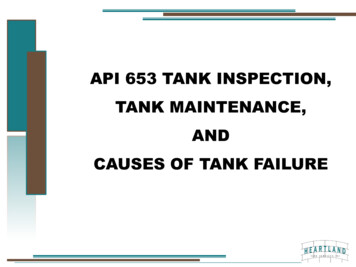
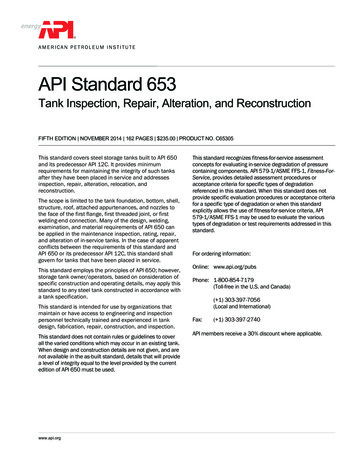
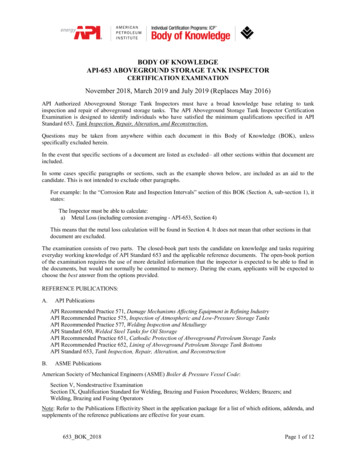
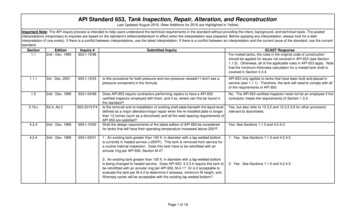
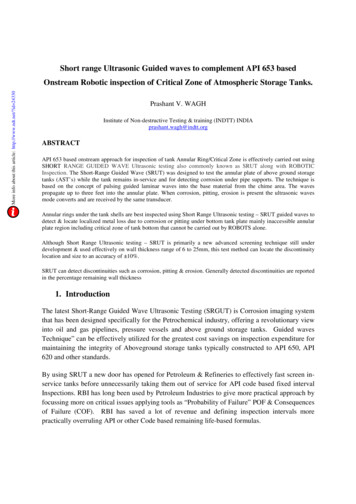
![API Ballot: [Ballot ID] – API 510 & API 570, Deferrals, Rev05](/img/5/api510andapi570deferralsrev5.jpg)
